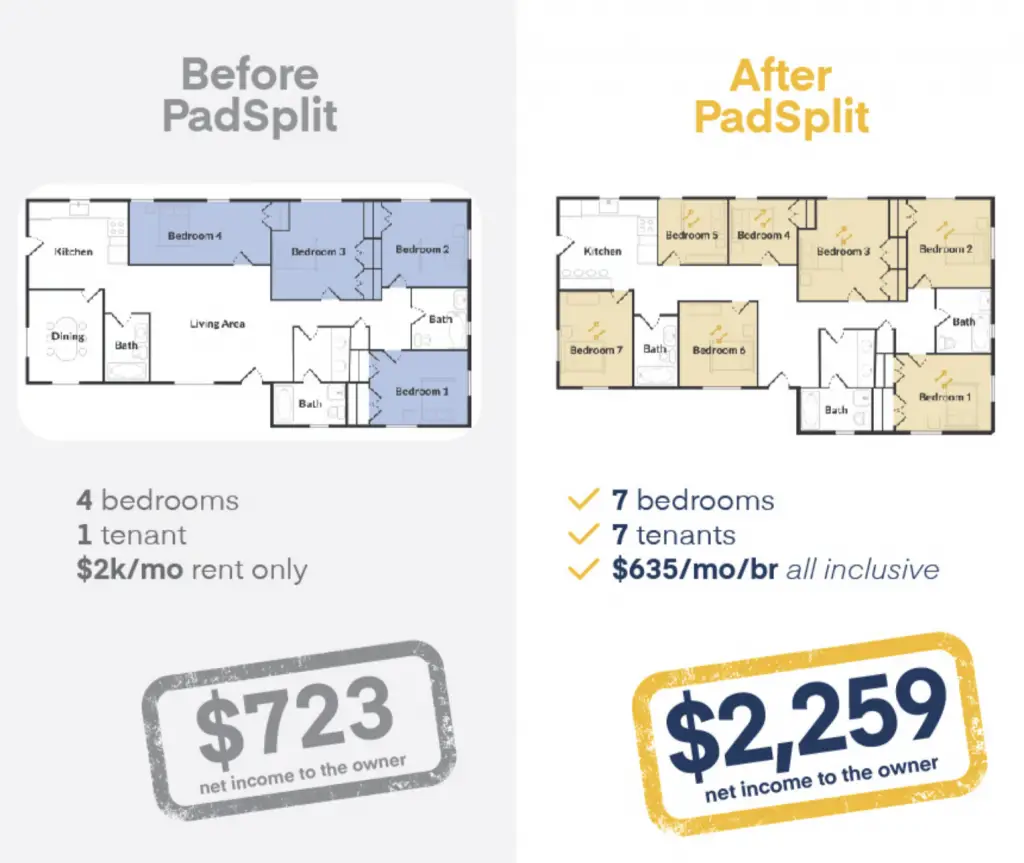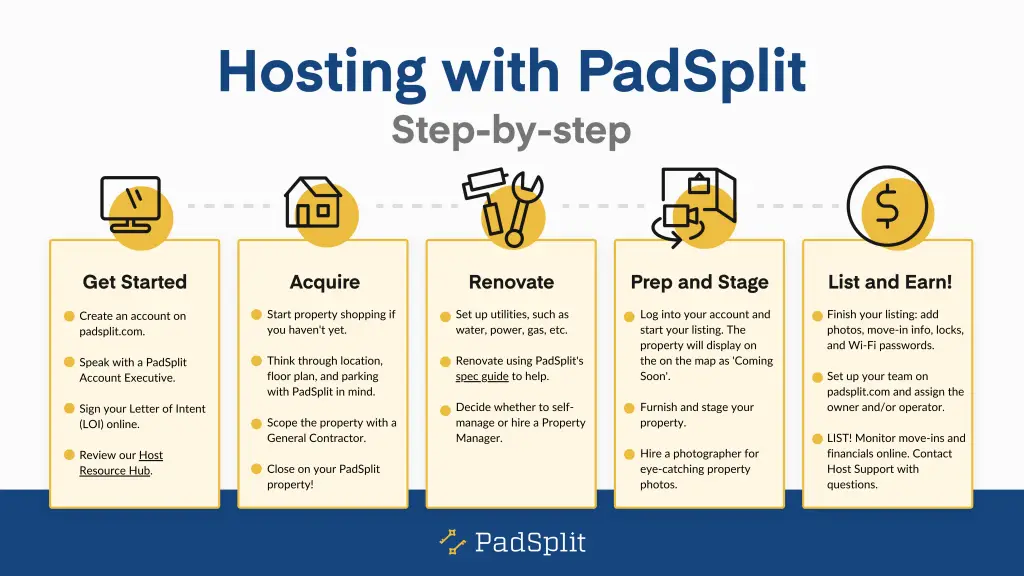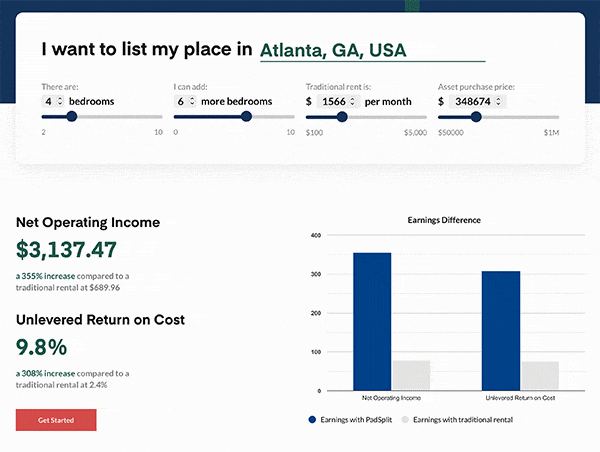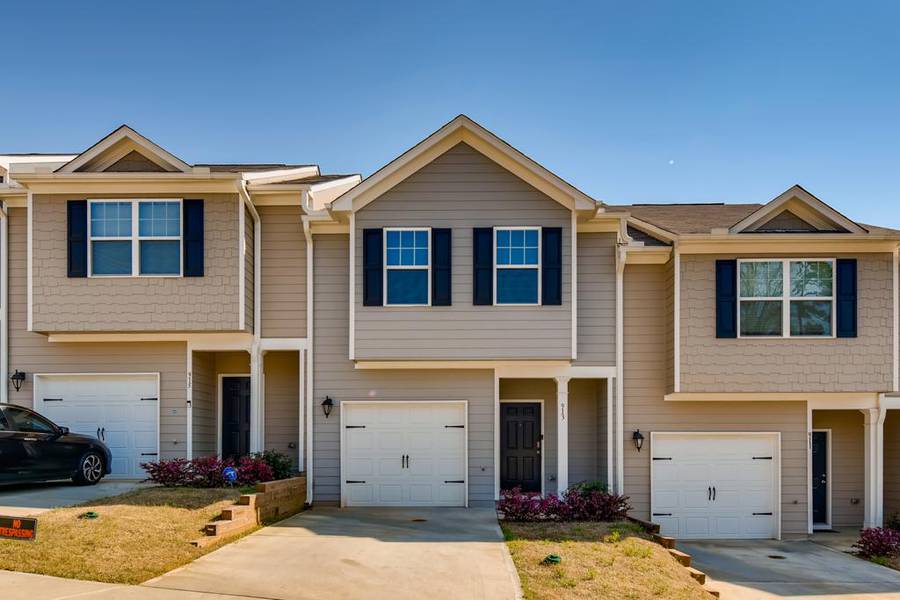Investing in real estate has long been considered to be one of the most reliable ways to build wealth. With returns comparable to those of the stock market, but with less inherent risk, real estate investments are an attractive way to diversify your portfolio. In recent years, passive real estate investing — whether through traditional real estate investment trusts (REITs), real estate crowdfunding opportunities, or shared housing through vacation rentals or coliving — has gained popularity as a way to maximize real estate’s earning potential.
As coliving continues to be a rapidly growing trend in the housing market, we are reviewing PadSplit, which claims to be the country’s largest coliving marketplace designed for workers.
What is Coliving?
First, we’ll explain the concept of coliving. The concept has received considerable buzz in recent years, partially because of the nationwide housing shortage and pandemic-related effects (labor shortages, more people working remotely, supply chain issues creating delays for construction, and generally the lack of affordable housing).
Many people don’t realize that coliving is actually not a new idea at all. Co-living, or as it was called, boarding, was an extremely popular, widely accepted type of rental property throughout the 20th century. Many individuals who worked in factories boarded. Families lived in duplex homes alongside other families and shared common areas. So the concept isn’t actually a new idea at all, but rather the rebirth of an older model. Of course, coliving is still an accepted form of living for college towns and senior housing.
More recently, AirBnB deserves credit for normalizing the idea of sharing a home to increase profitability. Co-living is a different approach for a different use-case, sure, but “house hacking” overall is now a common practice for new and experienced property owners, and in every city in the U.S., not just vacation destinations.
What is PadSplit?
PadSplit was founded in 2017 by Atticus LeBlanc, a housing advocate whose background was in traditional single-family rentals. While supportive of public housing and subsidized rent relief programs, Atticus saw firsthand how slow and inefficient these programs were and how they couldn’t help anywhere near enough people. Then, in a chance encounter, residents from a neighboring home asked if they could move into one of his vacant homes and pay by the week. This is how the original concept for PadSplit came to be.
Atticus realized we need a “both-and” approach, with public and private options, and that he could align the needs of individuals who sought housing while also increasing income generated by unused rooms in existing homes, all without taxpayer dollars. The founding team included Frank Furman and Jon O’Bryan, who helped to operationalize and create proprietary technology for PadSplit’s two-sided marketplace.
Today, PadSplit operates more than 3,500 coliving units and has housed more than 6,000 individuals (these numbers are growing daily). Unlike other coliving companies, like Common which focus on young professionals, PadSplit approaches coliving with a mission-driven model and focuses on providing a shared housing option specifically for the workforce. PadSplit’s website states that their residents, which they refer to as “Members,” earn a median income of $25,000 annually, and typical occupations for residents include grocery and restaurant workers, daycare center staffers, retail employees, and other community workers.
As a marketplace, PadSplit connects these individuals to landlords, or “hosts” as they call them, who have converted their homes into PadSplits. Each PadSplit includes a furnished bedroom and shared common areas, and the monthly payment is inclusive of utilities, wifi and usually a washer/dryer. PadSplit’s also offer their residents access to telehealth, job matching services and provide credit reporting for all on-time payments. PadSplit’s do not require long-term commitments, a credit score to apply or a security deposit; offerings the company often points to in support of its mission-driven approach.

How Does PadSplit Work and What Are the Costs?
There are a few different types of ways that PadSplit works with property owners. But the most common approach steps are below. PadSplit offers a variety of resources for host optimization, and each host is assigned an Account Executive to act as their main point of contact throughout the process.
- The property owner usually has existing homes available and is interested in learning more about a PadSplit. If not, PadSplit can offer guidance on where to buy and what to look for in a new property.
- The first step is to fill out the form so PadSplit can schedule a call to learn more about your interests and your goals.
- Part of the process typically involves converting underutilized common areas into bedroom space. PadSplit has a list of contractors they can provide to help you with this, and will advise you along the way, but you’ll need to take on this process and associated costs yourself. You’ll also need to provide furnishings for common areas and some basic accommodation for bedrooms (residents provide their own bed linens). Your Account Executive will provide a detailed specifications guide as an outline.
- Once the renovation is complete, PadSplit will do an in-person or video walkthrough of your home. Once approved, it will go live on the PadSplit website.
- At this point, PadSplit takes over to handle marketing, vetting of applicants (including background checks and income verification), coordinating move-ins, payment collections, handling any resident issues, etc. If there are maintenance requests, residents can connect through an app to put in a ticket for the property owner to address, or the property owner can utilize PadSplit’s service to handle and take care of requests (for an additional fee in certain markets).
- PadSplit has a dedicated call center to handle any resident customer service issues or disputes.
- PadSplit handles payments, collections and any late fees/disputes and communicates everything through a Host dashboard.
- Sit back and enjoy the additional income from your new PadSplit rental property! Seventy percent of Hosts expand to include additional homes through PadSplit’s marketplace.
Costs typically include:
- Home prep to convert underutilized space into bedrooms
- Furnishings (PadSplit advises low-flow, higher efficient fixtures and provides guidance)
- Providing wifi + utilities
- PadSplit fee of 12%
- Optional PadSplit fee of 8% for their property management service
Not sure you want to go the renovation route? PadSplit’s just launched a new service, PadSplit Turnkey, that allows investors to hand the entire process over while still maintaining ownership of the home. If you’re interested in learning more, you can schedule a call with the team.

Why Should a Landlord Consider PadSplit?
First and foremost, PadSplit states that, on average, its Hosts see an increase of more than 2X for net operating income, while maintaining an occupancy rate of 90%. Through its coliving model, hosts are encouraged to convert under-utilized common areas, such as a formal living room, into bedrooms to maximize opportunities for income. This concept is also referred to as “house-hacking.” PadSplit offers an earnings calculator to see how property owners can increase income through the model

PadSplit serves a resident manager for each property on the platform and is responsible for marketing to prospective residents, vetting individuals who apply and handling all payment collections. With PadSplit’s backend technology, each resident can have a customizable payment schedule so they can align the timing of payments to their work pay periods, making it easier for them to budget as well as easier for Hosts to receive their payments. PadSplit receives a fee of 8-15% of each payment for its services. The rate varies based on the amount of outsourcing each host elects to have PadSplit manage. For example, some Hosts choose to also take advantage of PadSplit property management and cleaning services rather than handling those tasks themselves.
In terms of coliving, PadSplit is one of the larger operators in the space, due to its expansion beyond its home market of Atlanta. At the time of publication, PadSplit operates in the following markets:
- Atlanta
- Houston
- Jacksonville
- Tampa
- New Orleans
- Richmond
- Indianapolis
PadSplit states it is also open to launching in other markets, particularly where Hosts are eager to offer immediate rooms through its marketplace.
Lastly: PadSplit states that another reason Hosts utilize its marketplace is because many rental property owners want to do both well and good, with not only increasing profitability but also supporting PadSplit’s mission of supporting community workers who seek more affordable housing options.
For this reason and the others listed above, PadSplit says that 70% of Hosts choose to bring more of their units onto the platform after their first experience.
Is PadSplit Legit?
PadSplit is the country’s largest shared housing marketplace that’s designed specifically for the workforce. They operate more than 3,500 units across the country.
To date, PadSplit has raised $35.1 million from a cadre of investors.
PadSplit is also an award-winning company, with the following distinctions:
- Inc’s Best in Business top company for real estate (2021)
- PropTech Breakthrough’s Affordable Housing Solution of the Year (2021)
- Inman Innovators finalist (2021)
- Atlanta Business Chronicle Pacesetter fastest growing company in real estate (2021)
- Atlanta Business Chronicle Corporate Citizen of the Year (2021)
- Atlanta Inno 50 on Fire company (2021)
- TiE Atlanta Growth and Impact Awards finalist (2021)
- Technology Association of Georgia Top 10 Most Innovative company (2021)
Is PadSplit a Good Option For My Rental Property?
With real estate, those who show up early often realize the biggest benefits. Looking back to 2008 and 2009: the independent real estate developers who scooped up as many single-family homes as they could are certainly seeing the rewards from taking on that risk.
The same can be said for coliving. Operators who get in early on the model will stand to benefit most as the trend continues to take off.
To be fair, there are some challenges with coliving. There’s a steep learning curve for buying and readying the homes, as well as integrating new technologies for payments. There is much to learn about efficiencies for shared utilities and common spaces. There are regulations to be mindful of as well.
We view PadSplit as one of the most proven models currently available for coliving. Their results for property owners are solid and the fact that 70% choose to expand with them after trying out the model initially points to their successful approach. They’ve also received many industry accolades to increase their credibility.
However, as always, we recommend doing your homework when partnering with any real estate companies, vendors and marketplaces. PadSplit offers a variety of resources, case studies and webinars through their site.
There’s no question that coliving is a growing trend so it’s a worthwhile strategy to consider.

Disclosure: Some of the links in this post are affiliate links and Landlord Gurus may earn a commission. Our mission remains to provide valuable resources and information that helps landlords manage their rental properties efficiently and profitably. We link to these companies and their products because of their quality, not because of the commission.




